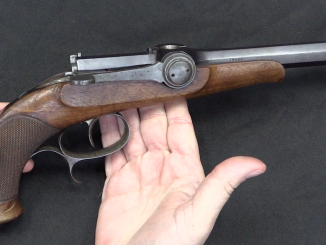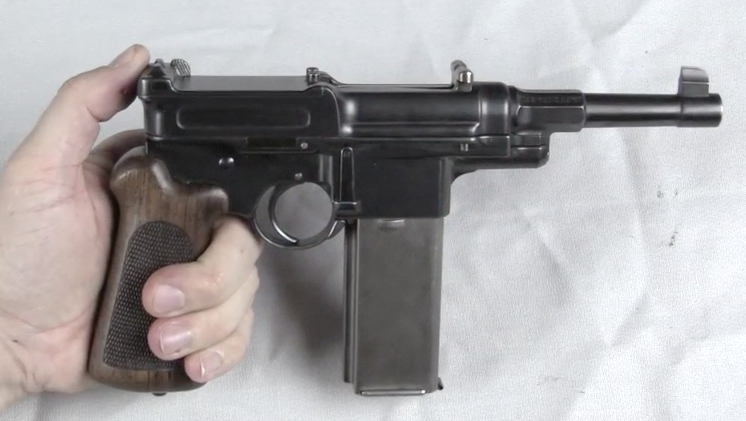In 1925, the German military began a series of secret SMG trials at the Kummersdorf testing grounds. One of the participants was Heinrich Vollmer. He was funded directly by the government for his small arms R&D until 1930, and iteratively developed his design until it went into large-scale production as the Erma EMP. What we are looking at today is the VMP 1930 pattern (a C&R transferrable example). At this stage, the gun had most of its final design elements, including a traditional box magazine, self-contained recoil spring system, and bare barrel. It also had a collapsing monopod in the vertical front grip, which would be later discarded.
Related Articles

Needlefire
Dreyse Model 1835 Needlefire Breechloading Pistol
Lot 408 in the September 2019 RIA auction. Johann Nicolaus Dreyse, later promoted to the aristocracy as Nicolaus von Dreyse, designed the first mainstream military breechloading rifle. His rifle was adopted by Prussia and changed […]

Aircraft MGs
Richard Wray Machine Gun Auction Followup
So, the auction of the late Richard Wray’s machine gun collection (see previous post) was yesterday, with the non-NFA guns being auctioned today. The final prices are interesting to look at, with some wallet-wrenchingly high […]

Prototype
Mauser 06/08 Semiauto Pistol at James D Julia
Throughout the pre-WWI period, Paul Mauser was working continuously to develop a reliable self-loaiding rifle. Among his many experimental designs was a flapper-locked rifle. The flapper-locking system was first patented by a Swede named Kjellman, […]

I missed it – what is that little dot of metal that came out of the bolt assembly?
Its the screw he took out in order to disassemble the bolt. Go to the 8:40 min mark in the video to see him take it out
According to http://modernfirearms.net/en/submachine-guns/germany-submachine-guns/emp-35-erma-eng/ EMP.35 Erma
EMP also had one more unusual design feature – a disassembly catch that was located at the rear of the trigger guard. There was nothing wrong with it – until shooter hit it with his fingers during combat, which resulted in instant self-disassembly of the weapon – a very unwelcome event for any fighting soldier.
“(…)Kummersdorf testing grounds(…)”
Wait… as far I know during WW2 Kummersdorf facility was tasked with evaluation of captured enemy tanks, e.g. this https://www.worldwarphotos.info/gallery/ussr/tanks-2/t-37-tank/t-37a-kummersdorf/ T-37A. Was that same facility, two different with one for tank and one for infantry weapons in same town xor two different facilities in two different town of same name?
https://www.mp40.nl/index.php?page=emp does claim that
(…)Erma adopted practically unchanged the VMP 1930 and started to market with two barrel lengths (200 and 320 mm). Erma later reintroduced the perforated heat shield around the barrel, but there were no other significant modifications. The weapon had a traditional stock with a small pistol grip on the hand guard; magazine remained in the horizontal position, inserted from the left side. Cocking handle was on the right side. Based on customer’s request the pistol grip might contain a telescoping monopod to help stabilize the weapon during fire. Since 1932 the weapon was marketed as EMP (Erma Maschinenpistole) or MPE (Maschinenpistole Erma) in Germany and abroad both.(…)
Which suggests that monopod was still available as option, I wonder how much it costed?
“(…)SMG With a Monopod?(…)”
After hitting that question mark I expected to see Mors wz. 39 http://modernfirearms.net/en/submachine-guns/poland-submachine-guns/mors-wz-39-eng/ it did also sported other features not commonly found in post-WW2 sub-machine gun like quick-change barrel (which was not so quick in practice).
Kummersdorf started as a test center for weapons and later also for motor vehicles. The 3 km long straight road along the eastern limit of the firig range was originally built after WW1 with vehicle speed tests in mind, as Wolfgang Fleischer reports.
The area where German and foreign vehicles and tanks were tested (called Kraftfahrversuchsstelle) is to the south and southeast of the firing range area, towards the village Horstwalde.
Kummersdorf was also where the HWA first stuck von Braun and his VfR buddies. Until they realized that even static tests of liquid rocket motors (LRMs) wasn’t something you wanted anywhere close to bunkers filled with artillery rounds and etc.
That’s when somebody remembered a disused militia training ground in Mecklenberg-Vorpommen, on the Baltic where the Oder comes out through three exits. This one was called the Peene.
In German, “Mouth of the Peene” is…Peenemunde.
clear ether
eon
What is the reason the magazine is positioned in a forward angle?
Why is the magazine angled forward?
9×19 mm cartridge is tapered, it looks like some sub-machine gun designer though it is beneficial to locate stick magazine at not-right angle. Examples include Steyr-Solothurn S1-100 see https://commons.wikimedia.org/wiki/File:MP_34.JPG and HK 54 see 1st photo from top here http://modernfirearms.net/en/submachine-guns/germany-submachine-guns/hk-mp5-eng/
https://www.rockislandauction.com/detail/86/375/erma-vpk-submachine-gun-class-iiinfa-cr
after examining the weapons put up for auction, another doubt arises this is not a Spanish folding Erma without a barrel jacket, it is a ready-made, consciously made Vollmer machine gun, with brass or bronze sockets Volmer used in his submachine guns as early as 1928, and perhaps from beginning. Spanish folds below in the photo, and V.P.? sn 28 of the Norwegian Police purchased in 1932 also with a brass magazine well. Photo: Forsvarsmuseet https://nphs.no/vapen-m-v/
There is no Spanish connection to the VMP; Rock Island’s description of the VPK as a “variant employed by Francoist Spain” is not true at all.
The Spanish Republican government produced a copy of the Erma EMP during the Spanish Civil War (along with a clone of the MP 28,II). After the war ended and the remnants of the defeated Republican forces fled to France, they were interned and disarmed by the border police there and the French confiscated some 3,250 Spanish-made EMP copies (which were later issued to French troops during WWII). The new Francoist regime confiscated the machine tooling that had been used to manufacture the EMP in Valencia and moved to the military arsenal at La Coruña where it was used to manufacture the M41 and M41/44 variants that were adopted by the Spanish Army after the Civil War.
Apart from probably a small trial batch of Erma EMPs procured before the Civil War, the Spanish never purchased any VMPs or EMPs from Germany and never obtained a production license. All EMPs in Republican and Francoist service were unlicensed clones, and Erma-Werke never did anything about it because Spanish patent laws at the time did not respect foreign inventions.
http://firearms.96.lt/pages/ErmaEMP.html
There is a very silly modern-day cops vs. robbers drama in Spain–Casa de Papel/aka. “Money Heist” that went on for far too many seasons because the first one was a hit. In the conclusion to the mini-series, there’s a special forces goon squad whose leader is packing one of the Franco Spanish State-era M41 A Coruña submachine gun. Cool visual reference for the gun nerds among us.